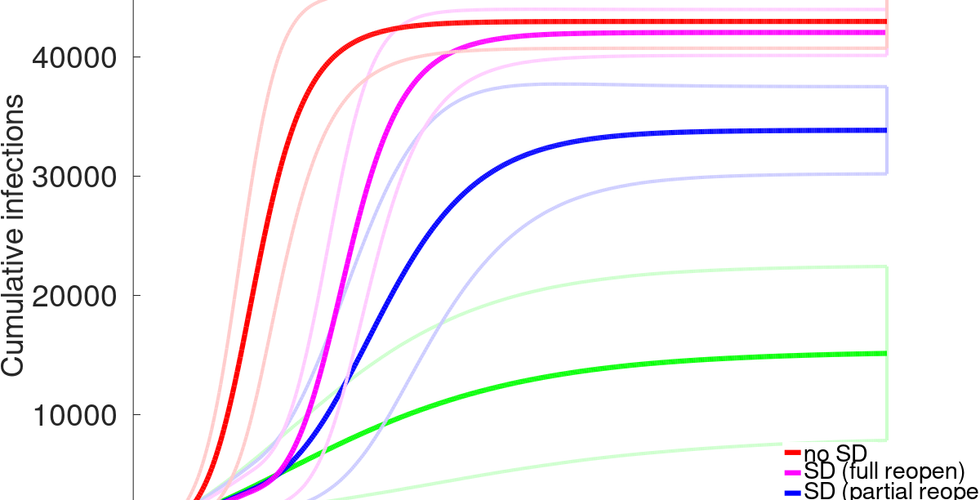Would intermittent social distancing work?
- Mark J. Panaggio
- Apr 30, 2020
- 3 min read
In a previous post, I looked at the effects of a complete or partial return to normal behavior after 40 days of intense social distancing on the spread of COVID-19. The takeaway message was that returning to normal behaviors too soon causes the number of new cases to start increasing again and, depending on the level of social distancing that is maintained over the long haul, the cumulative total number of cases can even be close to the unmitigated scenario. If social distancing is maintained throughout (over 1-1.5 years!!!!) then that scenario is avoided, but it is hard to imagine that being sustainable.
That got me thinking: Is there a way that we could use some sort of intermittent social distancing as a compromise? How effective would this be? So I decided to tweak the model so that after a 40 day period of intense social distancing (like we have been dealing with over the past month or so), the catch-all parameter R0, which is an aggregation of the effects of things like hand washing, mask wearing, keeping a 6 ft distance, staying home, closing schools, etc., alternates between the low level observed during the “lockdown” (which is 50% lower than normal) and a higher value.
I looked at two of these scenarios:
Scenario A: 5 days open (high R0), 2 days closed (low R0)
Scenario B: 2 days open (high R0), 5 days closed (low R0)
The thinking was that this might approximate either social distancing on weekends only or having freedom of movement on weekends only.
I also looked at 3 different levels for the high value of R0 during these brief “open” periods: 75% of the pre-COVID-19 levels, 100% of the pre-COVID-19 levels, and 125% of the pre-COVID-19 levels. The thinking was that there are two factors opposing to consider. On the one hand, rational people will still be cautious during the open periods, so they will probably not behave exactly like they would under normal conditions. On the other hand, people may try to cram more activity into those brief open periods, so this could actually increase their risk of exposure. Since it is not clear which of those two factors will be more significant, I tried R0 values that were both lower and higher than normal levels.
As a reminder, here are the results with constant R0 after reopening.
Below we have the intermittent scenario where R0 reaches 75% of its normal level during open periods. Here we see a dramatically lower peak (figure 1) in both the 2 closed, 5 open and 5 closed, 2 open scenarios. The total number of people that get infected (figure 2) is also about 30% and 50% lower than the unmitigated case respectively (Note: the case with intense social distancing for the entire time has around 70% fewer infections than the unmitigated case). This suggests that lifting restrictions on activity for brief periods does cause the disease to spread further, but it does not completely offset the benefits of "flattening the curve" as we saw in the full reopen case above where activity returned to normal. Could that allow for enough activity to get the economy moving again?
Next we have the intermittent scenario where R0 reaches 100% of its normal level during open periods. In this case, the benefits of social distancing are further reduced but not completely offset.
In the final scenario, R0 actually rises to 125% of normal levels during open periods. This is meant to describe a scenario where people rush out and try to fit most if not all of their normal activities into the brief open period. Restaurants and shops are crowded and as a result the virus is transmitted even more often than it would be with a normal routine. In this scenario, the peak and total number of cases are actually even higher than in the unmitigated scenario. In other words, intermittent social distancing could make things worse than doing nothing if it results in even more risky behavior than usual during the open periods.
So, what is the takeaway message. Is this a good idea? Would it be practical to implement? Would it be effective? Would it look more like the 75% case or the 125% case? It is hard to say.
From a selfish perspective, I like the idea of feeling like it is ok to have a small group of friends over or play pickup basketball once in a while. However, the model suggests that before implementing a strategy like that, it would be important to investigate further to determine if such a strategy would preserve all that has been accomplished over the last 6 weeks or if it would make things worse.
PS The idea of intermittent social distancing is not original. It has been proposed previously by a number of different research groups, but I like to verify things for myself.



























Comments